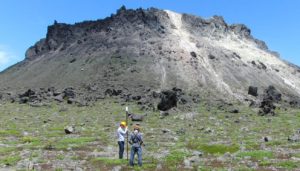Education
Overview
 Students who would like to carry out their research at the Institute of Seismology and Volcanology (ISV) will belong to one of the four research laboratories: (1) Seismological Observation, (2) Ocean Bottom Seismology and Tsunami, (3) Volcano Physics, or (4) Subsurface Structure. As these laboratories are collaborating closely, students will be provided with a wide range of research opportunities as well as a deep knowledge of their research interests. We believe this is a very important circumstance for bringing up active and productive researchers with a wealth of ideas.
Students who would like to carry out their research at the Institute of Seismology and Volcanology (ISV) will belong to one of the four research laboratories: (1) Seismological Observation, (2) Ocean Bottom Seismology and Tsunami, (3) Volcano Physics, or (4) Subsurface Structure. As these laboratories are collaborating closely, students will be provided with a wide range of research opportunities as well as a deep knowledge of their research interests. We believe this is a very important circumstance for bringing up active and productive researchers with a wealth of ideas.
Research at the Institute of Seismology and Volcanology (ISV)
When, where, why, and what size of earthquakes and volcanic eruptions will take place?
While earthquakes and volcanic eruptions are often a public concern, threatening our social basis, they can also be important clues to understanding the dynamics and evolution of the planet Earth. Earthquakes and volcanoes are so to say surface manifestations of the internal activity of the Earth; thus, understanding their mechanism and processes is one of the essential issues in geosciences.
We have been investigating the physical background of seismic and volcanic activities based on a multi-disciplinary approach, including seismology, geodesy, geothermics, fluid dynamics, electromagnetics, geology, and so on, in collaboration with domestic and international universities and research institutes.
For students, Hokkaido provides good opportunities to apply a wide range of knowledge that you have learned, such as physics, chemistry, mathematics as well as earth science, to real earthquakes and volcanoes.
Classes for Graduate Students
Classes taken by ISV faculty staff
| Course | Class | Teacher |
| Master | Applied Metrology to Seismology and Volcanology | Prof. Takahashi, Prof. Ohzono |
| Advanced Subsurface Exploration | Prof. Hashimoto, Prof. Murai | |
| Prognosis of Earthquakes and Volcanic Eruptions | Prof. Tanioka, Prof. Aoyama | |
| Seminar in Natural History Sciences 1 | All faculties | |
| Research in Natural History Sciences 1 | All faculties | |
| Doctor | Seminar in Natural History Sciences 2 | All faculties |
| Research in Natural History Sciences 2 | All faculties |
Several undergraduate classes are also in charge by ISV faculty staff.
Doctoral Theses
2023
- Tsuge, A., Dynamics of eruption and periodicity of Geysers, inferred from observations and numerical experiments of Shikabe Geyser
- Ratnasari, R.N., Development of Early Warning System for Volcanic Sector Collapse Tsunamis
2022
- Inoue, T., Study on the electrical resistivity structure of volcanoes based on magnetotellurics – Imaginf the magmatic and hydrothermal systems –
2019
- Narita, S., Variety of pre- and post-eruptive deformation associated with phreatic eruptions (Prof. Murakami)
2016
- Tanaka, R., Temporal development of volcanic hydrothermal system during inter-eruptive stages – Quantitative investigation by using numerical simulations – (Prof. Hashimoto)
- Yamada, T., A seismo-acoustic study of Vulcanian eruptions (Prof. Oshima)
2014
- Sabry, A. A., Three dimensional resistivity study by airborne elctromagnetics – Application to GREATEM field survey data – (Prof. Mogi)
2012
- Ioki, K., Source process of great earthquakes along the Kurile trench estimated from tsunami waveforms and tsunami deposit data (Prof. Tanioka)
2010
- Gusman, A. R., Source Process Determinations of Recent and Histrical Tsunamigenic Earthquakes using Tsunami Waveforms, Tsunami Inundation Data, Tsunami Deposits, and InSAR Data (Prof. Tanioka)
2008
- Abe, Y., Application of a multiply coupled Rayleigh oscillator model to seismicity simulations (Prof. Kasahara)
- Machida, Y., Crustal structure of the southernmost Kuril Trench of Hokkaido, Japan, by seismic tomography and Airgun-OBS profiling (Prof. Takanami)
2007
- Ichihara, H., Three dimensional crustal heterogeneity revealed by magnetotelluric method and its role for the generation of intraplate earthquakes (Prof. Mogi)
- Ghimire, S., Spatio Tmporal evolution of the state of stress in the Pacific slab subductiing in Hokkaido, Japan, before and after the 2003 Tokachi Oki earthquake (Prof. Kasahara)
- Yamaya, Y., Three dimensional resistivity structure of Tarumai Volcano by the magnetotelluric method including the effects of regional structure (Prof. Mogi)
2006
- Saba, M., Development of Geothermal Field following the 2000 Eruption of Usu Volcano (Prof. Mogi)
- Okada, J., Coincidental Subsidence During Magmatic Intrusion – A Case Study of Dacite Cryptodome Formation of Mt. Usu (Prof. Kasahara)
2005
- Miyagi, Y., Rapid inflation at Okmok volcano, Alaska, detected by GPS campaigns 2000-2003 and its source model (Prof. Kasahara)
- Asai, Y., Study on the Mechanism of Co-seismic Groundwater Level (Prof. Kasahara)
- Hoshimo, M., Self adaptive mesh refinement for the travel time tomography (Prof. Okada)
2004
- Toya, Y., Robust and Exploratory Analysis of Active Mesoscale Tectonic Zones in Japan Utilizing the Nationwide GPS Arrey (Prof. Kasahara)
2003
- Funja, W. E., Study on recent crustal movement of East African Rift System using GPS measurements (Prof. Kasahara)
2002
- Hatanaka, Y., Study on Optimal Analysis Strategy of Dense GPS Networks (Prof. Kasahara)
2000
- Saito, M., Bouguer anomaly and 3-D crustal modeling of the whole Peruvian Andes using the completely revised gravity data (Prof. Kasahara)
